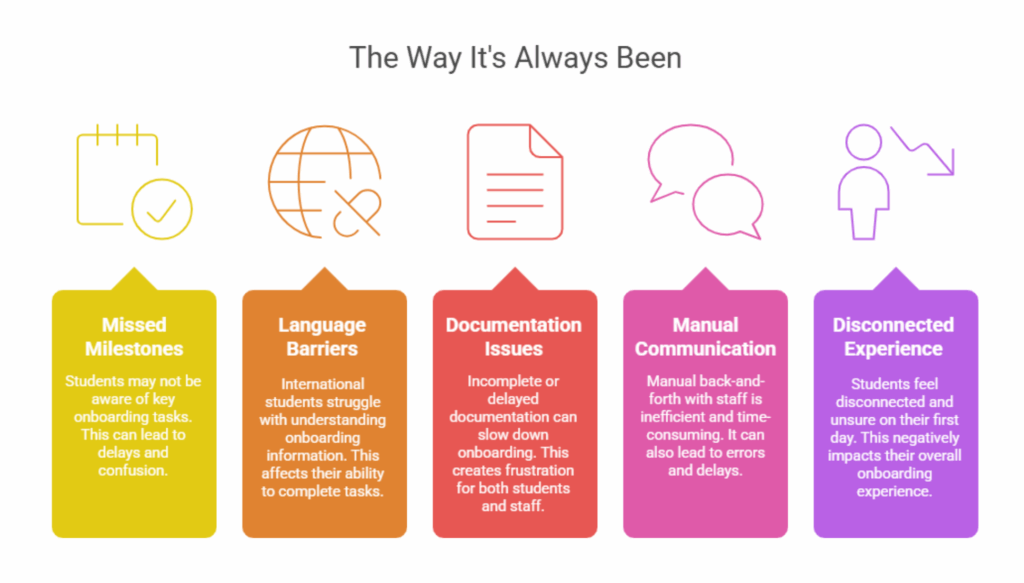The Chaos of Day One: Where the Real Bottlenecks Begin
A student’s first day of college is harrowing in more ways than one. There’s the emotional smorgasbord of nervous excitement, but also the logistical nightmare that often accompanies first-day jitters: a mile-high stack of forms, missing documents, incorrect class schedules, and the inevitable line of students outside the administration office. On the other side of the door, things are no less chaotic. Student advisors, new and experienced, are scrambling to process last-minute paperwork, reconcile data errors in spreadsheets, and field the same questions dozens of times.
This is where Agentic AI steps in. With the promise of reshaping the future of student onboarding, Agentic AI can navigate complex workflows and respond to real-time needs across the onboarding journey. In sharp contrast to manual onboarding processes and traditional automation, Agentic AI systems are autonomous, adaptive, and goal-driven. This translates to fewer bottlenecks and smarter coordination for institutions, and for students, a first-day experience that finally lives up to the promise of higher education.
Let’s dig deeper.
What Is Agentic AI and Why Should It Matter to Higher Education?
Higher education institutions in the U.S. are accelerating the adoption of artificial intelligence (AI) across the student journey—from admissions to classroom engagement. Technologies like natural language processing (NLP) and machine learning (ML) are no longer theoretical; they’re being actively deployed to support core academic and administrative functions. But as AI moves from experimental to operational, a new challenge is emerging: scaling AI without losing control, context, or human oversight. That’s where Agentic AI makes a difference, not as a replacement for faculty or staff, but as a new model of intelligence designed to work alongside them.
Agentic AI is a modular form of artificial intelligence built around a network of specialized, autonomous micro-agents, each designed to perform a distinct task independently while collaborating with others to achieve broader outcomes. Key differentiators include:
- Micro-agent architecture: Instead of one monolithic AI model, Agentic AI deploys a set of task-specific micro-agents, each one focused on a defined academic or administrative function (e.g., reviewing an application, responding to a syllabus query, flagging a student’s risk of drop-out).
- Plug-and-play deployment: These agents don’t require overhauling your learning management systems or student portals. They integrate via APIs, ingest structured and unstructured data (transcripts, essays, LMS activity logs), and provide real-time intelligence through familiar interfaces.
- Context-aware intelligence: An agent assisting in admissions can weigh essay quality, GPA, extracurriculars, and institutional fit, all the while surfacing inconsistencies or high-potential applicants without applying rigid scoring formulas.
- Privacy-aware orchestration: Unlike general-purpose AI, Agentic AI in education is configured to operate within FERPA and institution-specific compliance frameworks. Every decision or suggestion is auditable, traceable, and overridable by a human.
We’re already seeing this in action. In a 2023 survey by Intelligent.com, nearly 400 education professionals reported that 50% of college admissions departments were already using AI tools for application screening and review. An additional 82% of respondents said their institutions planned to implement AI in admissions by the following year, underscoring a clear trend toward AI-driven decision-making in higher education.
Beyond admissions, universities are embedding AI to enhance teaching, feedback, and student support. The University of Michigan, for example, has launched a campus-specific version of ChatGPT designed for students and faculty, with built-in privacy and academic integrity safeguards. At the University of Pennsylvania, the Graduate School of Education is piloting JeepyTA, an AI-powered teaching assistant that responds to syllabus queries, generates assignment feedback, and helps manage the volume of student emails. These early implementations signal a broader shift: institutions are not just digitizing existing processes; they’re reimagining the entire academic lifecycle with intelligent automation and personalization at its core.
Let’s take a closer look at three areas where it’s already making a meaningful impact: admissions, onboarding, and retention.
Streamlining Student Onboarding
As artificial intelligence (AI) continues to reshape the academic landscape, the next natural frontier for higher education is streamlining student onboarding. This critical phase, often marked by paperwork, delays, and fragmented communication is now ripe for intelligent automation. While many universities already use AI-powered tools like predictive analytics, chatbots, and virtual assistants, the real breakthrough lies in adopting Agentic AI.
Where traditional AI responds to prompts, Agentic AI takes initiative, operating with autonomy, context awareness, and a clear sense of purpose. They operate with context, take initiative, and can orchestrate complex workflows across student-facing and back-end systems. For colleges and universities seeking not just incremental improvements but full transformation, Agentic AI offers a path to make onboarding independent, personalized, and dynamic.
Here’s what that looks like in practice:
- Dynamic workflow orchestration: Micro-agents coordinate across admissions, housing, financial aid, and academic advising, ensuring that one task (like course registration) isn’t triggered until prerequisite steps (like transcript verification) are complete. No more disconnected silos.
- Real-time document intelligence: Rather than just collecting forms, agents use AI-powered OCR and validation to read transcripts, check completeness, verify ID proofs, and flag anomalies, all in one automated flow with full audit trails.
- Persona-based onboarding: Agentic AI adapts onboarding steps based on the student’s background (e.g., international, transfer, first-gen), major, and intended program. A computer science student might be nudged toward GitHub tutorials and programming communities, while a literature major receives different resources entirely.
- Multi-agent coordination: One agent reminds a student to submit housing forms; another monitors FAFSA status; a third initiates outreach if orientation deadlines are missed. The result is a system that feels personal even when scaled to thousands.
- Accessibility-first design: Agents are built to accommodate multilingual inputs, screen readers, and cognitive load limitations, ensuring that onboarding is inclusive from the first interaction.
- Smart mentorship matching: Based on behavioral data, course interests, and activity logs, agents match students with relevant peers, advisors, or clubs transforming social integration from optional to engineered.
This isn’t just onboarding. It’s orchestrated intelligence that evolves with the student, from day one to graduation.
Optimizing Enrollment Support
It’s no secret that universities are often overwhelmed during peak enrollment periods. From housing and financial aid inquiries to advisor scheduling and paperwork backlogs, the first few weeks of a new academic term can stretch even the most organized institutions. Long queues, missed deadlines, and overburdened support teams have become the norm.
Agentic AI is quietly changing that story, not by automating individual tasks, but by orchestrating the entire support ecosystem.
With AI agents trained specifically on student onboarding workflows, colleges are replacing friction with flow. These autonomous micro-agents don’t just wait for commands, they detect issues, initiate action, and synchronize systems in real time. They can flag incomplete applications before they become bottlenecks, automatically nudge students toward next steps, and update internal platforms the moment documents are submitted.
Here’s how that plays out:
- Real-time system sync: When a student submits their immunization form, one agent logs the document, another updates the SIS, and a third unlocks the student’s course registration—without any human intervention.
- Bottleneck prevention: Agents monitor application pipelines, identify where students are stalled, and trigger proactive support—long before the delay becomes a help desk issue.
- Advisor load balancing: Based on agent-driven analysis of appointment requests, availability, and complexity, students are routed to the right advisor at the right time, reducing wait times and burnout.

Some institutions are already laying the groundwork. The California State University (CSU) system, in partnership with OpenAI, has deployed ChatGPT Edu across its 23 campuses. While this AI is not yet fully agentic, it automates high-volume student support at scale—handling queries, reducing administrative load, and accelerating response times. It’s a signal of where the industry is headed: a move from assistive AI to autonomous orchestration.
That evolution is especially critical for international student onboarding, where language gaps, time zone mismatches, and unfamiliar systems create additional friction. With multilingual AI agents, institutions can guide students through visa documentation, personalized course selection, and housing, all while adapting communication preferences (voice, chat, or text) to suit the student’s context. It’s not just automation. It’s inclusive, intelligent onboarding that meets students where they are. The result? Support that’s not only faster—but smarter, fairer, and fundamentally more human.

Driving Student Retention Outcomes
Retention has always been one of higher education’s most stubborn challenges. Despite the best efforts of faculty, advisors, and support staff, students drop out for reasons ranging from academic struggles and financial stress to lack of belonging or poor time management (Mission Graduate) Traditional interventions are often reactive, kicking in only after the warning signs become obvious, and sometimes, too late.
Agentic AI flips this model. Instead of waiting for students to self-identify as at-risk, autonomous micro-agents continuously monitor behavioral, academic, and engagement data across platforms, surfacing early indicators of disengagement and triggering real-time interventions.
Here’s how Agentic AI actively supports student retention:
- Behavioral early-warning systems: Agents analyze LMS activity, attendance logs, assignment submissions, and even discussion board participation. A sudden drop in engagement? The system flags it, escalates it to the right advisor, or initiates outreach via email, SMS, or chat—automatically and with context.
- Contextual nudges with purpose: Not every missed assignment signals a dropout risk. Agentic AI filters out the noise and focuses on patterns, tailoring nudges based on academic history, personal circumstances, and program intensity. A reminder sent to one student might be a support offer sent to another.
- Personalized academic scaffolding: If a student begins to fall behind in a course, agents can recommend supplemental materials, schedule tutoring sessions, or activate peer mentoring without waiting for faculty to notice or intervene.
- Real-time emotional pulse checks: Using sentiment analysis across emails, chat logs, and surveys, agents can detect when a student expresses stress, frustration, or disengagement and automatically initiate check-ins or mental health referrals while maintaining privacy thresholds.
- Lifecycle-based interventions: Agents track student progress from onboarding to graduation. They know when midterms hit, when internship applications are due, and when financial aid needs renewal providing proactive, just-in-time support throughout the academic year.
The value isn’t just in catching risk early, it’s in making retention systemic, scalable, and personalized. With Agentic AI, universities can shift from broad retention strategies to precision support models that adapt to each student’s journey whether they’re struggling silently or simply need a small nudge to stay on track. Walsh University deployed AI-powered tools like the Student Retention Predictor to guide interventions, achieving a sustained average retention rate of 76.3% across seven cohorts (Ruffalo Noel Levitz).
Agentic AI workforce for Intelligence at Scale
For institutions ready to move beyond basic automation, platforms like FD Ryze are turning the promise of Agentic AI into a campus-wide reality. FD Ryze is an autonomous Agentic AI platform that deploys micro-agents capable of managing—not just supporting—critical academic and administrative workflows. These agents perform tasks like eligibility checks, document validation, and admissions optimization with full autonomy, mimicking the functions of an intelligent, always-on workforce.
But the impact doesn’t stop at onboarding. FD Ryze extends into academic operations, curriculum planning, and student services, transforming reactive support models into proactive, orchestrated systems. The result is a dynamic, self-evolving education ecosystem. One where students are guided with intention, not funneled through generic processes.
In a competitive, outcomes-driven landscape, Agentic AI is no longer just a technology upgrade; it’s a strategic imperative. From reducing administrative overhead to improving student satisfaction and retention, AI-powered orchestration enables institutions to scale intelligently while delivering higher-quality, personalized experiences. And as enrollment pressures rise and students demand digital-first, consumer-grade experiences, adopting AI that thinks, adapts, and acts autonomously gives institutions a clear edge.
It’s not about replacing people. It’s about reimagining how people and intelligent systems work together to deliver smarter, more scalable education at every touchpoint. Ready to see what’s possible inside your own institution? Let’s start with one agent. Schedule a demo today!
And if you want to see it live, join us at Tech Xchange 2025 with 250+ enterprise pioneers as the world’s first enterprise-grade autonomous agents take the stage, reasoning, planning, and self-optimizing in real time. No slides. No simulations. Just applied AI, live and working. Click to know more.




